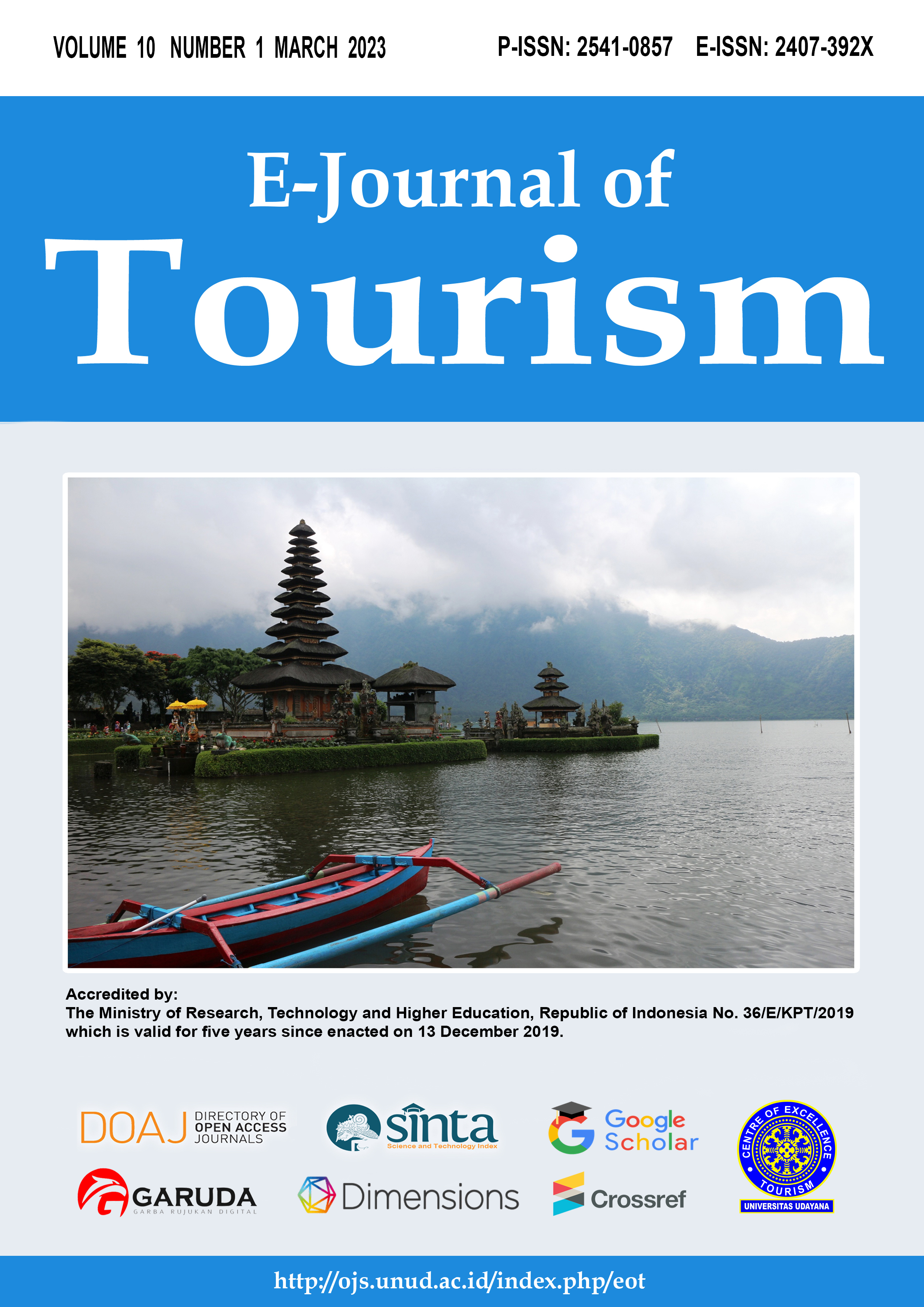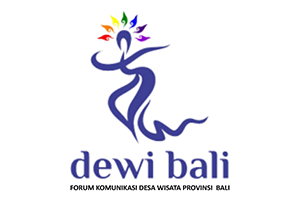The Happiness of European Tourists (HoET) in Bali: Tourism Services and Happiness Types
Abstract
European tourists are the primary market of Bali. Therefore, tourism stakeholders consider them as the leading market segment for tourism business and marketing. The main objective of the local tourism industry, when providing services and hospitality, is to generate happiness for European tourists. Based on this background, this research aims to identify the characteristics and types of happiness experiences of European tourists to choose tourism services in Bali. Data are collected through structured interviews, observation, and documentation studies. Respondents consist of 100 European tourists who visited Bali. They are determined by the non-probability sampling method. Data are analyzed by Nvivo 12, statistics, and described qualitatively. The results of the study show that the characteristics of European tourists are dominated by the age of 15-30 years old, female, undergraduate, not married, employee of a private company, to visit colleagues, travel with a friend or spouse, independent travelers, first-time visit, and length of stay of 14 days. The category known as ‘Happiness of European Tourists (HoET)’ in Bali. They are taking various tourism services, including accommodation, dining at restaurants, tours and travel, transportation, local tour guides, tourist attractions, and tourism infrastructure. These aspects are typically classified within the domain of ‘happy’. Upon analyzing the feedback on tourism services, it becomes evident that restaurant services bring the highest level of happiness to European tourists visiting Bali. This finding closely aligns with the tourist response to the accommodation services, which also ‘very happy’. In addition, the empirical research shows that culinary experiences and lodging services hold paramount delight for European tourists during their travels in Bali.
Downloads
References
Andereck, K. L., Valentine, K. M., Vogt, C. A., & Knopf, R. C. (2007). A cross-cultural analysis of tourism and quality of life perceptions. Journal of Sustainable Tourism, 15(5), 483-502.
Antara, M., & Sumarniasih, M. S. (2017). Role of tourism in economy of Bali and Indonesia. Journal of Tourism and Hospitality Management, 5(2), 34-44.
Antaranews.com. 5 Januari 2016. https://bali.antaranews.com/berita/84029/bali-raih-pulau-terbaik-asia-2015
Badan Pusat Statistik Provinsi Bali (2022). Statistik Daerah Provinsi Bali 2022: Badan Pusat Statistik Provinsi Bali
Bruni, L. (2004). The “technology of happiness” and the tradition of economic science. Journal of the History of Economic Thought, 26(1), 19-44.
Buhalis, D., Harwood, T., Bogicevic, V., Viglia, G., Beldona, S., & Hofacker, C. (2019). Technological disruptions in services: lessons from tourism and hospitality. Journal of Service Management.
Club Med. (2022). Worlds happiest holiday destinations 2022. https://www.clubmed.co.uk/l/blog/worlds-happiest-holiday-destinations-2022.
CNBC Indonesia. (2022). Tempat Wisata Paling Bahagia di Dunia, Bali masih Juara. https://www.cnbcindonesia.com/research/20221214080739-128-396669/tempat-wisata-paling-bahagia-di-dunia-bali-masih-juara
CNN Indonesia. 3 September 2017. Restoran di Bali Raih Penghargaan Terbaik Se Asia. https://www.cnnindonesia.com/gaya-hidup/20170803071147-262-232085/restoran-di-bali-raih-penghargaan-terbaik-se-asia
Cohen, E. (1985). The tourist guide: The origins, structure and dynamics of a role. Annals of tourism research, 12(1), 5-29.
Conde Nast Traveler. 2022. https://www.cntraveler.com/inspiration/readers-choice-awards
Cukier-Snow, J., & Wall, G. (1993). Tourism employment: perspectives from Bali. Tourism Management, 14(3), 195-201.
Dann, G. M. S. (1979). Tourist satisfaction: A highly complex variable. Annals of Tourism Research, 4, 110–113.
Dann, G. M. S. (2012). Tourist motivation and quality-of-life: In search of the missing link. In M. Uysal, R. R. Perdue, & J. M. Sirgy (Eds.), The handbook of tourism and quality of life research (pp. 233–250). Dordrecht: Springer
Davis, D. D. (2008). Terminating therapy: A professional guide to ending on a positive note. John Wiley & Sons.
Deery, M., Jago, L., & Fredline, L. (2012). Rethinking social impacts of tourism research: A new research agenda. Tourism Management, 33, 64–73.
Deery, M., Jago, L., & Fredline, L. (2012). Rethinking social impacts of tourism research: A new research agenda. Tourism Management, 33, 64–73.
Filep, S., & Deery, M. (2010). Towards a picture of tourists' happiness. Tourism Analysis, 15(4), 399-410.
Fu, Y. K., & Wang, Y. J. (2020). Experiential value influences authentic happiness and behavioural intention: Lessons from Taiwan’s tourism accommodation sector. Tourism Review.
Garner, B., Thornton, C., Pawluk, A. L., Cortez, R. M., Johnston, W., & Ayala, C. (2022). Utilizing text-mining to explore consumer happiness within tourism destinations. Journal of Business Research, 139, 1366-1377.
Gavurova, B., Suhanyi, L., & Rigelský, M. (2020). Tourist spending and productivity of economy in OECD countries–research on perspectives of sustainable tourism. Entrepreneurship and Sustainability Issues.
Gempi.co. 20 Februari 2018. https://www.genpi.co/berita/11/13-kali-bali-raih-the-best-island-in-asia-pacific-pariwisata-indonesia-luar-biasa
Goossens, C. (2000). Tourism information and pleasure motivation. Annals of tourism research, 27(2), 301-321.
Hair, Joseph F, Black, W. C., Babin, B. J., Anderson, R. E., & Tatham, R. L. (2006). Multivariate Data Analysis. In sixth edition pearson Education (Ed.), New Jersey. Prentice Hall.
Hinkin, T. R. (1995). A review of scale development practices in the study of organizations. Journal of Management, 21(5), 967–988.
Hobson, J., & Dietrich, U. (1994). Tourism, health and quality of life: Challenging the responsibility of using the traditional tenets of sun, sea, sand, and sex in tourism marketing. Journal of Travel and Tourism Marketing, 3, 21–38.
John, F. H, & Shun Wang, Haifag Huang, & Max Marton. (2022). Chapter 2; Happiness, Benevolence, and Trust During COVID-19 and Beyond. World Tourism Report; https://worldhappiness.report/ed/2022/happiness-benevolence-and-trust-during-covid-19-and-beyond/
Kim, S., Choe, J. Y., King, B., Oh, M., & Otoo, F. E. (2022). Tourist perceptions of local food: A mapping of cultural values. International Journal of Tourism Research, 24(1), 1-17.
Kompas. (2022). Bali jadi destinasi liburan paling Bahagia dunia 2022, kalahkan dubai. https://travel.kompas.com/read/2022/08/19/171931727/bali-jadi-destinasi-liburan-paling-bahagia-dunia-2022-kalahkan-dubai.
Kumparan. 10 November 2019 Restoran di Bali Raih Tripadvisors Travelers Choice Award 2019. https://kumparan.com/kumparanfood/restoran-di-bali-raih-tripadvisors-travelers-choice-awards-2019-1sE2BJkiDQl
Kwon, J., & Lee, H. (2020). Why travel prolongs happiness: Longitudinal analysis using a latent growth model. Tourism Management, 76, 103944.
Laba, I. N., Semara, I. M. T., & Tunjungsari, K. R. (2018). Dampak Terpaan Informasi Media Digital terhadap Perkembangan Pariwisata dan Perilaku Masyarakat Bali. Jurnal Kajian Bali (Journal of Bali Studies), 8(2), 178.
Leaman, O. (1980). Ibn Rushd on happiness and philosophy. Studia Islamica, (52), 167-181.
Lee, H., Lee, J., Chung, N., & Koo, C. (2018). Tourists’ happiness: are there smart tourism technology effects?. Asia Pacific Journal of Tourism Research, 23(5), 486-501.
Lepore, M., Gayle, G. W., & Stevens, S. F. (1998). Adapted aquatics programming: A professional guide. Human Kinetics, PO Box 5076, Champaign, IL 61825-5076.
Li, Y., Song, Y., Wang, M., & Huan, T. C. T. (2021). The influence of tour guides’ service quality on tourists' tour guide stigma judgment: An asian perspective. Journal of Hospitality and Tourism Management, 48, 551-560.
Liputan 6. (2022). Bali Di Daulat sebagai destinasi liburan paling Bahagia di Dunia. https://www.liputan6.com/lifestyle/read/5048235/bali-didaulat-sebagai-destinasi-liburan-paling-bahagia-di-dunia-2022
Lv, X., & Wu, A. (2021). The role of extraordinary sensory experiences in shaping destination brand love: An empirical study. Journal of Travel & Tourism Marketing, 38(2), 179-193.
Lyubomirsky, S., & Lepper, H. S. (1999). A measure of subjective happiness: Preliminary reliability and construct validation. Social Indicators Research, 46(2), 137–155.
Mkono, M., Markwell, K., & Wilson, E. (2013). Applying Quan and Wang's structural model of the tourist experience: A Zimbabwean netnography of food tourism. Tourism management perspectives, 5, 68-74.
Mochón, F. (2018). Happiness and technology: special consideration of digital technology and internet.
Mohammad, Bashar Aref; Mat Som, Ahmad Puad (2010). An Examination of Satisfaction on Tourism Facilities and Services in Jordan. Anatolia, 21(2), 388–392.
Musikanski, L. (2014). Happiness in public policy. Journal of Social Change, 6(1), 5.
Nawijn, J., & Peeters, P. M. (2010). Travelling ‘green’: is tourists' happiness at stake?. Current Issues in Tourism, 13(4), 381-392.
Pai, C. K., Liu, Y., Kang, S., & Dai, A. (2020). The role of perceived smart tourism technology experience for tourist satisfaction, happiness and revisit intention. Sustainability, 12(16), 6592.
Paramita, I. B. G. (2021). Mengelola Komunikasi Efektif Public Relation Sektor Pariwisata Di Bali Pada Masa Pandemi Covid-19. Communicare, 2(2).
Pearce, P. L., & Lee, U.-I. (2005). Developing the travel career approach to tourist motivation. Journal of Travel Research, 43, 226–237.
Pencarelli, T. (2020). The digital revolution in the travel and tourism industry. Information Technology & Tourism, 22(3), 455-476.
Picard, M. (1999). The discourse of kebalian: transcultural constructions of Balinese identity. Staying local in the global village: Bali in the twentieth century, 15-49.
Poon, A. (1988), “Tourism and information technologies”, Annals of Tourism Research, Vol. 15 No. 4, pp. 531-549.
Puczko´, L., & Smith, M. (2012). An analysis of tourism QOL domains from the demand side. In M. Uysal, R. R. Perdue, & J. M. Sirgy (Eds.), The handbook of tourism and quality of life research (pp. 263–278). Dordrecht: Springer.
Ram, Y., Nawijn, J., & Peeters, P. M. (2013). Happiness and limits to sustainable tourism mobility: a new conceptual model. Journal of Sustainable Tourism, 21(7), 1017–1035.
Republika. (2022). Selama 2022 ada 68 kasus kecelakaan dialami bule-bule di Bali. https://news.republika.co.id/berita/rqsq0f330/selama-2022-ada-68-kasus-kecelakaan-dialami-bulebule-di-bali
Sahin, G. G., & Sengün, G. (2015). The effects of social media on tourism marketing: a study among university students. Management and Administrative Sciences Review, 4(5), 772-786.
Sea Asia. 13 September 2022. Bali Named Wordls Happiest Holiday Destination in 2022. https://seasia.co/2022/09/13/bali-named-world-s-happiest-holiday-destination-in-2022
Smith, S. L. J. (1990). A test of Plog’s allocentric/psychocentric model: Evidence from seven nations. Journal of Travel Research, 28(4), 40–43.
Sthapit, E. (2018). Is there more to the effects of tourists’ local food consumption on post-consumption behaviour?. Anatolia, 29(4), 614-616.
Travel Kompas. 24 Oktober 2022. 8 Resor di Balu Masuk Daftar Resort Terbaik Dunia 2022. https://travel.kompas.com/read/2022/10/24/075943327/8-resor-di-bali-masuk-daftar-resor-terbaik-dunia-2022
Tshiteem, K., & Everest-Phillips, M. (2016). Public service happiness and morale in the context of development: the case of Bhutan. Asia Pacific Journal of Public Administration, 38(3), 168-185.
Utama, I. G. B. R., & SE, M. (2015). Pengantar Industri Pariwisata. Deepublish.
Vickers, A. (2013). A history of modern Indonesia. Cambridge University Press.
Warmayana, I. G. A. K. (2018). Pemanfaatan digital marketing dalam promosi pariwisata pada era industri 4.0. Pariwisata Budaya: Jurnal Ilmiah Agama Dan Budaya, 3(2), 81-92.
Yamashita, S. (2003). Bali and beyond: Explorations in the anthropology of tourism (Vol. 2). Berghahn Books.
Yuksel, A. (2001). Managing customer satisfaction and retention: A case of tourist destinations, Turkey. Journal of vacation marketing, 7(2), 153-168.
Zhou, X., Chen, S., Chen, L., & Li, L. (2021). Social class identity, public service satisfaction, and happiness of residents: the mediating role of social trust. Frontiers in Psychology, 12, 659657.

This work is licensed under a Creative Commons Attribution 4.0 International License.
The copyright of the received article shall be assigned to the journal as the publisher of the journal. The intended copyright includes the right to publish the article in various forms (including reprints). The journal maintains the publishing rights to the published articles.




















